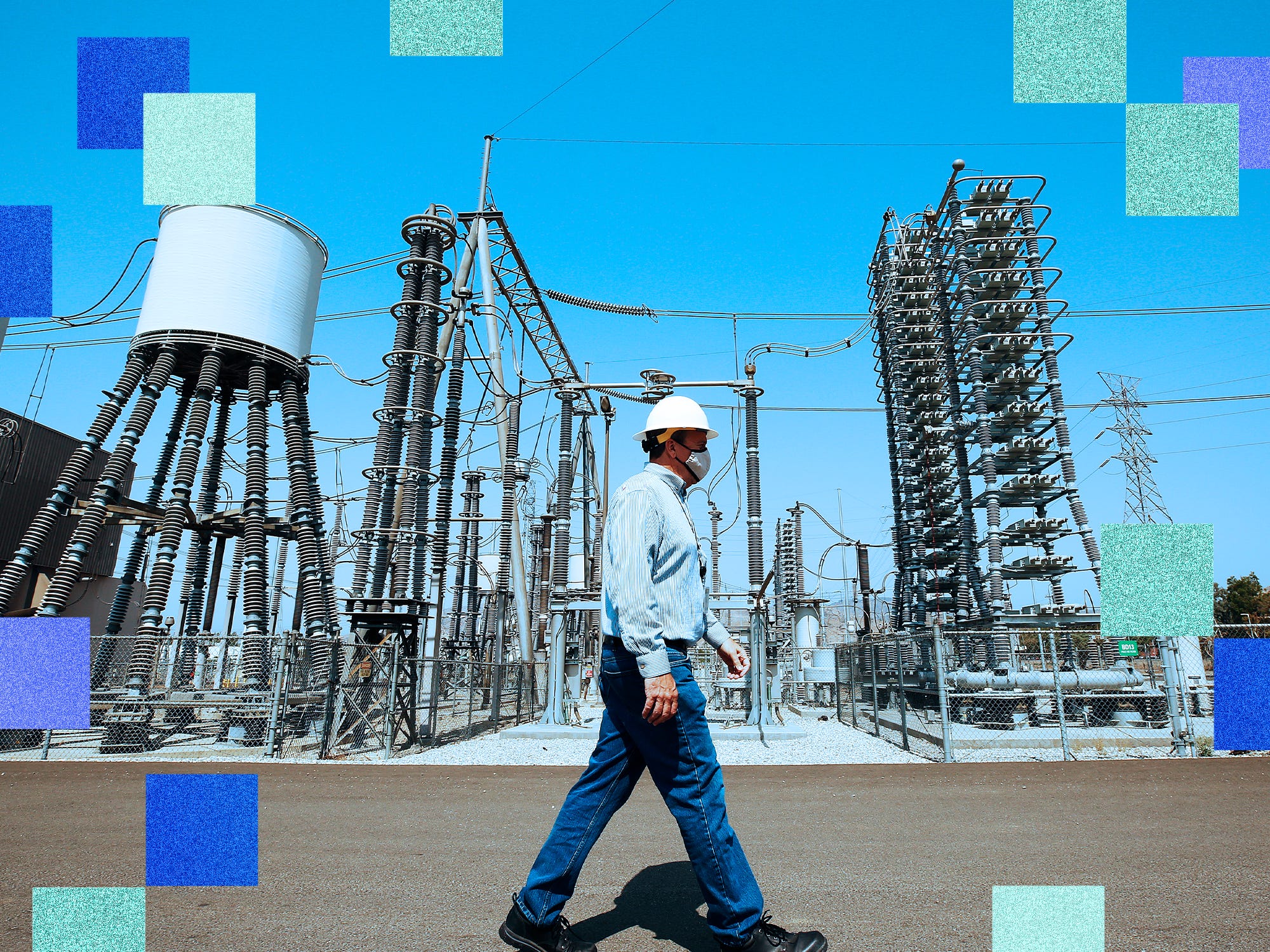
Al Seib/ Getty Images; Alyssa Powell/BI
After decades of wear and tear, the US energy grid is starting to reach its breaking point.
The traditional grid system was designed for a time when electricity demand was steady and less intense. Today, the grid faces a mountain of unprecedented stressors. Accelerating electrification, a surge in energy-hungry AI infrastructure like data centers, and the intensifying impacts of extreme weather fueled by climate change are pushing grid infrastructure to its limits, destabilizing the already vulnerable energy system.
These disruptions could result in blackouts that could cost American businesses up to $150 billion each year, according to the US Department of Energy, potentially leaving millions of consumers without reliable electricity.
In response, utilities are cautiously starting to embrace artificial intelligence as a tool to help stabilize grid operations. Once seen as just a budding technology, AI is emerging as one part of utilities’ strategies to anticipate disruptions, protect the grid’s equipment, and better serve a rapidly changing energy landscape.
AI is enhancing predictive maintenance
AI is sharpening the tried-and-tested tools utilities have been using to prevent failures across the energy grid.
One is predictive maintenance, where sensors and software are used to monitor the condition of grid equipment, like transformers and power lines, and spot issues to fix before they cause outages.
Predictive maintenance isn’t new. But integrating machine learning into the process has made detecting faulty equipment faster and more precise, according to Somjyoti Mukherjee, a consulting partner at Cognizant, an IT consulting firm.
Sensors embedded in circuit breakers, switch gears, and transmission lines feed real-time data into AI systems, which then analyze patterns to forecast when components are likely to fail.
“Predictive maintenance is delivering the fastest returns,” Mukherjee, who leads grid modernization efforts for North America’s utilities sector, told Business Insider.
Murkherjee pointed to one utility client with outdated systems that left field-technician crews wasting hours daily because they couldn’t catch issues in time. After switching to an AI-driven maintenance system, the software recommended tools, suggested equipment replacements, and located defects in real time, allowing crews to work “smarter and faster,” Murkherjee said.
Duke Energy, an American energy provider, is also tapping into AI to identify grid vulnerabilities. The Fortune 500 utility provider developed a hybrid AI system that blends machine learning with expert diagnostics to flag high-risk equipment. The tool is designed to monitor the health of Duke’s transformer fleet, a connected web of circuits that transmit electricity from one board to another.
Duke’s hybrid approach combining human expertise with AI-powered insights has led to “more consistent identification of problematic equipment” and “improved planning decisions,” said Matt Carrara, the president of Doble Engineering.

Courtesy of Doble Engineering
Some startups are pushing AI’s capabilities even further.
Rhizome is working with Seattle City Light, Vermont Electric Power Company, and other US grid operators to map out climate-driven risks before they strike. Co-founded by CEO Mishal Thadani, the platform uses AI to analyze historical grid data, outage causes, and environmental threats, such as wildfires, storms, and vegetation growth, down to the level of individual poles and wires.
The result is a digital risk map that guides where to invest in upgrades and maintenance for the biggest impact per dollar. One utility in Texas, for example, used Rhizome’s predictive model to identify which circuits in its energy system were at high risk of impact by storm activity so the utility could invest capital into improving vulnerable equipment. In doing so, the Texas utility reduced storm-induced outages by 72%, according to Rhizome.
As utilities face tighter budgets, rising insurance costs, and increasing pressure from climate change and power-hungry data centers, Thadani said platforms like Rhizome can help them make more strategic investments into grid improvements.
“More utilities need to be very conscious about the investments they’re making,” Thadani told BI, adding that big capital decisions must be “justified with data and evidence to show that ratepayer value.”

Courtesy of Rhizome
Energy providers are exploring new AI tools
Beyond maintenance, utilities are adopting new AI tools to better understand and manage physical equipment in the field.
Peter Nearing, a principal advisor at Stantec, an engineering consulting group, pointed to one of his firm’s utility clients that deployed cameras with image recognition to automatically capture, identify, and digitize equipment data. Doing so improved the quality and speed of data collection, leading to less time spent gathering intel, better decision-making on equipment fleets, and, in turn, fewer manual site visits.
Implementing computer vision technology into the grid is part of a larger shift toward using AI for pattern recognition and data-heavy tasks, such as forecasting demand, mapping outages, and streamlining upgrades.
“This is where AI shines,” Nearing told BI regarding the technology’s data-handling capabilities.
Some utilities are now turning to generative AI to make fieldwork easier, too. In March, Avangrid, a US renewable energy supplier, launched “First Time Right Autopilot,” a genAI tool trained on the company’s internal manuals, troubleshooting guides, and other internal documents. Accessible on mobile devices through voice or text, the chatbot can answer technicians’ repair questions in real time.
For instance, if a wind turbine goes offline, a technician can ask the AI assistant how to fix it. The tool analyzes the issue using contextual data on the turbine’s equipment and provides step-by-step instructions.
Since implementing the AI tool, Avangrid has seen faster repairs and reduced downtime, according to Avangrid’s chief information officer Nelly Jefferson.
“It empowers our workforce by providing field technicians with real-time access to expert-level support,” Jefferson told BI.
Still, managing energy demand — especially during peak hours — remains a tough feat for AI to address, given the grid’s outdated infrastructure. It’s why most utilities are still in pilot mode when it comes to AI-driven load management, according to Vivian Lee, a Boston Consulting Group managing director with expertise in the energy sector.
Lee says that some are experimenting with short-term load forecasting, using real-time data like weather, usage trends, and local events to predict electricity demand hours or days in advance. Others are testing AI to control distributed energy resources like smart thermostats, EV chargers, and home batteries to slightly reduce or shift energy use during high-demand periods, easing strain on the grid.
These tools remain largely rule-based, where they only work when given instructions for specific use cases, limiting their widespread applications. But Lee sees long-term potential in AI to manage energy loads.
“Broad adoption of AI in load management is still in its early days,” Lee told BI.

Courtesy of Stantec
Roadblocks stand in the way of AI adoption
Despite rising optimism, the energy experts who spoke to BI said utilities companies are still finding it tough to adopt AI.
Many are still working with legacy IT and operational systems that don’t integrate easily, making it hard to pull together clean, usable data for AI to draw insights.
“Data quality and availability remain major hurdles,” said Lee.
Talent shortages add more friction. A lack of AI literacy across the workforce could make an organization more resistant to embracing new technologies, according to Nearing.
Regulatory bottlenecks make that transition even harder. The absence of clear guidelines on AI deployment in the energy sector creates hesitation among utilities, and utilities are required to navigate legal frameworks to ensure AI applications comply with data protection laws.
The Trump administration’s tariffs on imported components like transformers and metals have also spiked costs, further complicating project timelines, Carrara said.
Utilities turn to AI with caution
Still, many of these obstacles are no longer deal-breakers. Mukherjee says that utilities are making progress by migrating to the cloud, training employees how to use AI, and engaging with regulators to encourage technological change.
“Regulators are responding,” Mukherjee said, pointing to agencies like the US Federal Energy Regulatory Commission that are hiring technical experts and “leaning into innovation.”
Building trust is also key. Mukherjee, Nearing, and Lee emphasized starting small, focusing on low-risk, explainable use cases to build internal momentum, and involving frontline workers from day one.
Looking ahead, utility experts say energy providers are eager to continue exploring AI’s potential to modernize the grid to reduce strain.
But they have a long way to go before they can fully embrace AI with open arms.
“AI won’t replace core grid functions,” Lee said. “But it will increasingly act as an accelerant.”
The post Utilities are tiptoeing into AI as climate change and data center growth add stress to the energy grid appeared first on Business Insider.




